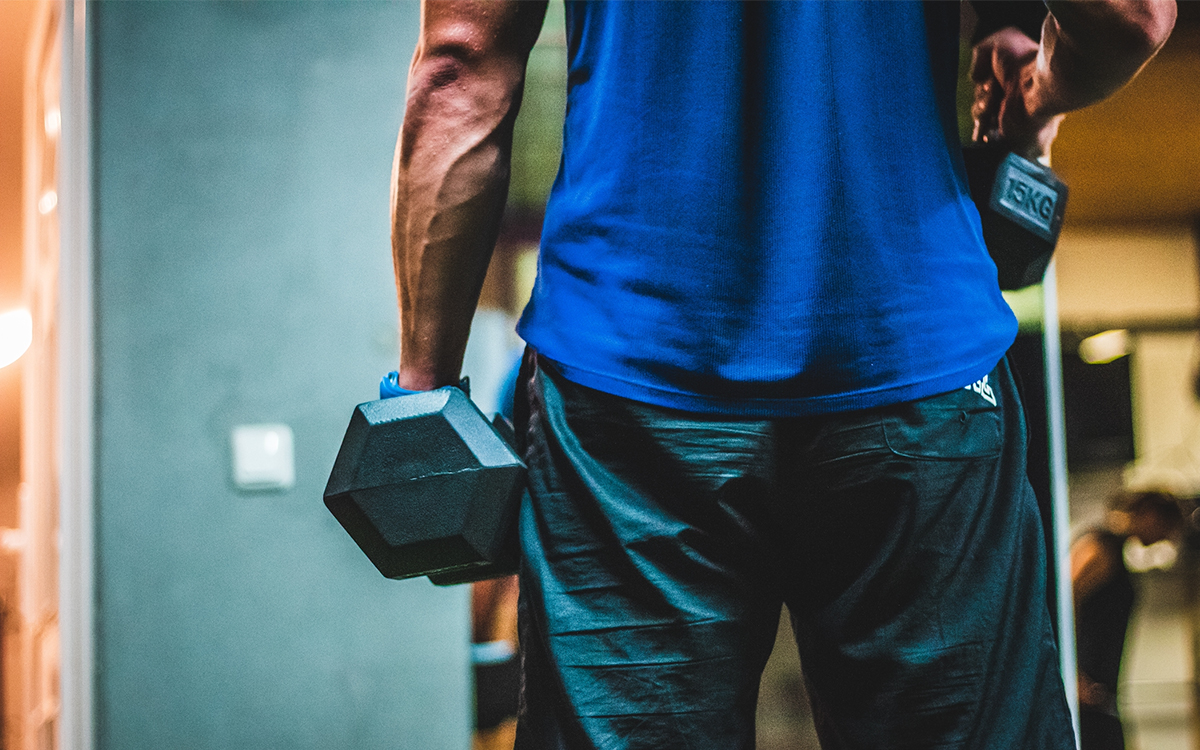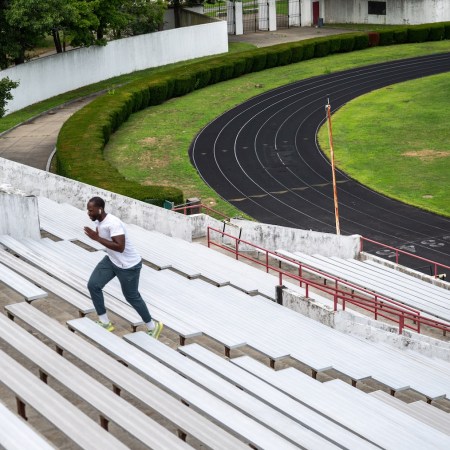“Pull-ups are a motherf*cker.”
That’s Eminem, a few years back, sharing his least favorite exercise in an interview with a men’s magazine. While their choice of words may have differed, most people who spend a significant chunk of time in the gym have reached a similar conclusion. Pulls-up absolutely suck. They’re tough even when you’re good at them, and when you haven’t completed one in a year (or five), they seem damn near impossible.
According to Torre Washington, trainer and expert at Centr (Chris Hemsworth’s fitness platform), the reason pull-ups are harder than push-ups “boils down to distribution of weight.” In a push-up, four different points maintain contact with the ground. Whether you’re conscious of it or not, your core and legs are shouldering some of the load.
But up there on the bar, your feet dangling futilely below, your upper body must account for every single pound, core and legs included. If you’re 185 pounds, you have to support 185 pounds. That’s not to say there aren’t upper body muscles designed to help you raise your body. In fact, 21 different muscles play a role in the action: everything from pecs to deltoids to a pair buried in your shoulder blades called rhomboids.
But when you perform a pull-up, and have your palms facing away from you (just past shoulder-width apart) you’re primarily engaging the latissimus dorsi. They’re the largest muscles in the upper body, and extend from your armpits to your lower back in a massive sheet. Chin-ups (palms facing you, arms more inward) use all the same muscles as pull-ups, but lean equally on the biceps and the lats. Meaning: if you’ve been cranking out prison curls since February, you’ll find chin-ups a little easier.
This is pretty common. Even people who don’t regularly lift or work out prefer chin-ups to pull-ups. It’s a more natural motion that engages the elbow flexors and takes less of a toll on shoulder rotation. And just as important, in our opinion, there’s less of a psychological barrier to attempting them. A large reason pull-up counts hover around zero is because so few people can bear to attempt them — the fear of failure, especially in front of onlookers, is real.
Which is why we asked Torre Washington for a workout that would A) directly strengthen the muscles needed to knock out pull-ups, while B) saving us from having to do traditional pull-ups. He came back with six exercises, spaced out over a 30-minute workout. None require substantial knowledge of equipment, or even a gym membership, and all will knock your lats, delts and company into fighting shape ahead of your battle with the bar.
Below, find the six exercises from Washington’s pull-ups prep workout. His two big rules before you go out attempting it? “Focus on contracting the scapula, and make sure to keep your hand-width grip just outside of the shoulders.” Which means, basically: take note of whether you’re properly pushing your shoulder blades toward the spine (a crucial motion that any technically sound pull-up requires), and always, always check your grip.
Good luck out there.
TRX rows
By now, you’re definitely familiar with TRX. It’s a form of specialized training designed by a former Navy SEAL that blurs the line between pilates and strength training. Try to get your hands on a set (most gyms have them tied/mounted to the wall these days, or you can pick one up for yourself here) and master the system’s most basic move. Plant your feet while holding on to the gripped cables, then slowly lean back into a 45-degree angle with the floor. Pull yourself up (contracting those shoulder blades), and then lean back again, stretching your arms out straight. Perform three sets, each with 15 reps.
Incline bench-supported scapular contractions
This is not the most difficult exercise on this list, but it’s probably the trickiest. Find an adjustable bench, or a piece of furniture with a natural incline, and lay your chest atop it, with your shoulders hunched. Reach down and slowly raise dumbbells with each arm while consciously pushing your shoulder blades back towards each other. It will be tempting to let your forearms or biceps handle the weight, but it’s important that you let your upper back and shoulders do the work. And go slow — this exercise is a waste of time if you race through it. We recommend starting off really light here to master the form. Do one set of 15 reps, with 7.5-pound dumbbells. Once you’re comfortable with the motion, move on to three sets of 10 reps, with dumbbells anywhere from 15-25 pounds.
Dumbbell front raise with thumbs up
You can either mix these in with the incline bench scapula work to create a circuit and avoid getting too bored, or simply perform your sets after. Nothing too fancy here. Grab two dumbbells, also in the 15-25 pound dumbbell range, and hold them straight out from your chest, with the plates facing the ground. Lower them slowly in a “V” down to your legs, then raise them back up to your starting position. If you’ve tried strength training and primarily focused on the mainstream stuff — bicep curls, tricep extensions, shoulder presses — you’re going find this move unusual. That’s because it’s a very inclusive, total-upper body exercise. Take it slow, and aim for three sets of 10 reps.
Lowered squat rack bar pull-ups
Your new best friend. Honestly. This move is similar to doing push-ups with your knees on the floor, only since we’re working with pull-ups here, it’s way harder. Head to a squat rack and place the bar on a rung at about eye level, or find any bar in the wild that’s around the same height (jungle gyms work). Then place two hands shoulder-width apart as you normally would to perform a pull-up. Keep your feet planted on the floor, and lower yourself into a seated position. Not using any strength from your legs, pull yourself up to complete a “pull-up.” Head back to your starting position. Then repeat. This exercise, better than any other option here, addresses how daunting the aerial aspect of pull-ups can be. Everything’s a little less intense from the ground, not to mention less strenuous. Though you’d be surprised how shot your upper body is going to feel after trying this out. Do three sets of 10 reps, 12 if you’re feeling good.
Eccentric loaded pull-ups
Now we’re ready to do some work on the real bar, though you’re not doing sequential pull-ups quite yet. Find yourself a little step-up box, and jump up onto the bar (checking your grip before you do so). Hold the pose for a second above the bar, and then as deliberately as you can, travel down to the ground, keeping your legs slightly curved forward. This is about finding and perfecting the shoulder contraction inherent in any good pull-up, plus building a familiarity with dangling from the bar. Once you finish one, you can hop off and take a breather. Do three sets of six reps each, and try to take note of how long it’s taking you to reach the ground. If you stretch it out to five seconds, you’re in good shape.
Renegade rows
People got bored of every other type of row, so they devised this diabolical push-up/row combo. Get down into a push-up position, with your hands gripping two dumbbells. (If you can find hexagonal dumbbells, it’s going to make your life easier, as they won’t roll away, but that’s no deal-breaker.) Slowly raise one dumbbell up past your chest, keeping your balance with your hand on the other dumbbell. Set the dumbbell back down, and repeat for the other side. This will hit everything, which is why it hurts so bad: you’ll feel this in your back, shoulders, triceps and biceps the following morning. Do three sets of 12, with six for each side.
Repeat this circuit 2-3 times a week. Obviously you’re welcome to check in on your actual pull-up progress at any time, but we recommend resisting the urge for a few months. When you finally do hit the bar, you’ll be delighted with the results.
The Charge will help you move better, think clearer and stay in the game longer. Subscribe to our wellness newsletter today.
























